Luminescence Dating of Holocene Fluvial Sediments from the Daluze Area in the North China Plain
Abstract
1. Introduction
2. Materials and Methods
2.1. Study Area
2.2. Sedimentary Characteristics of the Section and Sample Collection
2.3. Methods
2.3.1. Grain Size Analysis
2.3.2. OSL Dating
2.3.3. 14C Dating
3. Results
3.1. Grain Size Analysis Results
3.2. Dating Results
3.2.1. OSL Signal Characteristics
3.2.2. OSL Age Distribution
3.2.3. OSL Age Results
3.2.4. 14C Age Results
4. Discussion
4.1. Comparison of 14C and OSL Ages of Lacustrine Sediments
4.2. OSL Signal Bleaching Efficiency of Quartz in Different Grain Sizes of River Sediments
4.3. Differences in Quartz OSL Bleaching Efficiency of Fluvial Sediments Across Different Periods
4.4. Implication of OSL Dating for Fluvial Sediments in Plain Areas
5. Conclusions
- (1)
- Modern soil layer, mountain flood layer, fluvial flood layer, and lacustrine layer in the YC section has been identified based on field observations of lithological characteristics and sedimentary structures, as well as laboratory grain size analysis.
- (2)
- For the fluvial sediments deposited in the early and middle Holocene, fine-grained quartz exhibits concentrated De distributions, whereas most medium-grained and coarse-grained quartz shows more dispersed De values with significant positive correlations with Ln/Tn, indicating incomplete bleaching. By applying the MAM to small aliquots, the OSL ages of medium- and coarse-grained samples align well with those of fine grains.
- (3)
- The OSL ages of fluvial sediments deposited before 1 ka in the YC section are relatively reliable, attributed to better bleaching of finer grains. This contrasts with fluvial sediments deposited after 1 ka in the region, which commonly show age overestimation due to incomplete bleaching, despite better bleaching efficiency in coarser grains. The variation in bleaching efficiency suggests differences in sediment source distances and depositional processes around 1 ka ago. Based on the results, for fluvial sediments in the eastern plain of China, it is recommended to strengthen the comparison of OSL dating results for different grain-size quartz, combined with appropriate analytical models.
- (4)
- Transitions between lacustrine and fluvial sediments have occurred in the Daluze region during the Holocene. The main periods of fluvial deposition were concentrated in three intervals: 10.8~10.2 ka, 5.3~4.7 ka, and after 1 ka.
Author Contributions
Funding
Data Availability Statement
Acknowledgments
Conflicts of Interest
Abbreviations
| OSL | optically stimulated luminescence |
| ka | thousand years before the present |
| YC | Yanchi |
| MAM | the minimum age model |
| CAM | the common age model |
| AMS | accelerator mass spectrometry |
References
- Macklin, M.G.; Lewin, J. Alluvial responses to the changing earth system. Earth Surf. Process. Landf. 2008, 33, 374–1395. [Google Scholar] [CrossRef]
- Lam, D.; Croke, J.; Thompson, C.; Sharma, A. Beyond the gorge: Palaeoflood reconstruction from slackwater deposits in a range of physiographic settings in subtropical australia. Geomorphology 2017, 292, 164–177. [Google Scholar] [CrossRef]
- Yu, S.; Chen, X.; Cheng, P.; Chen, S.; Hou, Z. Freshwater radiocarbon reservoir age in the lower yellow river floodplain during the late Holocene. Holocene 2017, 28, 119–126. [Google Scholar] [CrossRef]
- Yu, S.; Li, C.; Chen, X.; Jin, G.; Fang, H. Rates of organic carbon burial in a floodplain lake of the lower yellow river area during the late Holocene. Radiocarbon 2014, 56, 1129–1138. [Google Scholar] [CrossRef] [PubMed]
- Rittenour, T.M. Luminescence dating of fluvial deposits: Applications to geomorphic, palaeoseismic and archaeological research. Boreas 2008, 37, 613–635. [Google Scholar] [CrossRef]
- Thrasher, I.M.; Mauz, B.; Chiverrell, R.C.; Lang, A. Luminescence dating of glaciofluvial deposits: A review. Earth-Sci. Rev. 2009, 97, 133–146. [Google Scholar] [CrossRef]
- He, Z.; Long, H.; Yang, L.; Zhou, J. Luminescence dating of a fluvial sequence using different grain size fractions and implications on Holocene flooding activities in Weihe basin, central China. Quat. Geochronol. 2019, 49, 123–130. [Google Scholar] [CrossRef]
- Smedley, R.K.; Skirrow, G.K.A. Luminescence dating in fluvial settings: Overcoming the challenge of partial bleaching. In Palaeohydrology. Geography of the Physical Environment; Springer: Cham, Switzerland, 2020. [Google Scholar] [CrossRef]
- Nian, X.; Zhang, W.; Wang, Z.; Sun, Q.; Chen, Z. Inter-comparison of optically stimulated luminescence (OSL) ages between different fractions of Holocene deposits from the Yangtze delta and its environmental implications. Mar. Geol. 2021, 432, 106401. [Google Scholar] [CrossRef]
- Perilla-Castillo, P.J.; Driese, S.G.; Horn, S.P.; Rittenour, T.M.; Nelson, M.S.; Mckay, L.D. Using soil micromorphology to assess the reliability of radiocarbon and osl dating of fluvial deposits. Phys. Geogr. 2023, 44, 710–762. [Google Scholar] [CrossRef]
- Breda, C.; Pupim, F.N.; Cruz, C.B.L.; Souza, P.E.; Monsalve, G.; Cardona, A.; Sawakuchi, A.O.; Parra, M. Variation in the ITCZ position controls the evolution of the piedmont landscape of the tropical Andes (Colombia) during the late Quaternary. Geomorphology 2024, 462, 109333. [Google Scholar] [CrossRef]
- Fuchs, M.; Fischer, M.; Reverman, R. Colluvial and alluvial sediment archives temporally resolved by OSL dating: Implications for reconstructing soil erosion. Quat. Geochronol. 2010, 5, 269–273. [Google Scholar] [CrossRef]
- Rizza, M.; Rixhon, G.; Valla, P.G.; Gairoard, S.; Delanghe, D.; Fleury, J.; Tal, M.; Groleau, S. Revisiting a proof of concept in quartz-OSL bleaching processes using sands from a modern-day river (the Séveraisse, French Alps). Quat. Geochronol. 2024, 82, 101520. [Google Scholar] [CrossRef]
- Madsen, A.T.; Murray, A.S.; Sukamoto, S.; Duller, G.A.T.; Murray, A.S.; Choi, J. Optically stimulated luminescence dating of young sediments; A review. Geomorphology 2009, 109, 3–16. [Google Scholar] [CrossRef]
- Kim, J.C.; Chang, T.S.; Yi, S.; Hong, S.S.; Nahm, W. OSL dating of coastal sediments from the southwestern Korean peninsula: A comparison of different size fractions of quartz. Quat. Int. 2015, 384, 82–90. [Google Scholar] [CrossRef]
- Hu, G.; Zhang, J.; Qiu, W.; Zhou, L. Residual osl signals in modern fluvial sediments from the Yellow river (Huanghe) and the implications for dating young sediments. Quat. Geochronol. 2010, 5, 187–193. [Google Scholar] [CrossRef]
- Thompson, J.A.; Chen, J.; Yang, H.; Li, T.; Bookhagen, B.; Burbank, D. Coarse- versus fine-grain quartz OSL and cosmogenic 10Be dating of deformed fluvial terraces on the northeast Pamir margin, northwest China. Quat. Geochronol. 2018, 46, 1–15. [Google Scholar] [CrossRef]
- Ishii, Y.; Tamura, T.; Collins, D.S.; Ben, B. Applicability of osl dating to fine-grained fluvial deposits in the Mekong river floodplain, Cambodia. Geochronometria 2021, 48, 351–363. [Google Scholar] [CrossRef]
- Chamberlain, E.L.; Wallinga, J.; Reimann, T.; Goodbred, S.L.; Steckler, M.S.; Shen, Z.; Sincavage, R. Luminescence dating of delta sediments; Novel approaches explored for the Ganges-Brahmaputra-Meghna delta. Quat. Geochronol. 2017, 41, 97–111. [Google Scholar] [CrossRef]
- Gray, H.J.; Mahan, S.A. Variables and potential models for the bleaching of luminescence signals in fluvial environments. Quat. Int. 2015, 362, 42–49. [Google Scholar] [CrossRef]
- Li, Y.; Sun, X.; Liu, Y.; Pei, Y. Timing of fluvial sedimentation in the Baiyangdian catchment, North China Plain, since the late Pleistocene by multiple luminescence dating approaches. Quat. Geochronol. 2024, 83, 101589. [Google Scholar] [CrossRef]
- Zhao, H.; Liu, Z.; Song, L.; Wang, C.; Li, S. Osl dating of flood sediments in the North China Plain. Quat. Geochronol. 2019, 49, 101–107. [Google Scholar] [CrossRef]
- Wang, S.; Miao, X.; Shi, T. Flood events in the lower reaches of the Yellow river: OSL and radiocarbon dating on the Anshang site. Quat. Int. 2024, 694, 13–25. [Google Scholar] [CrossRef]
- Du, T.; Zhang, W.; Li, B.; Liu, L.; Li, Y.; Ge, Y.; Yu, S. Sedimentary evidence for the diversion of the yellow river onto the North China Plain 3000–2600 years ago. Palaeogeogr. Palaeoclimatol. Palaeoecol. 2024, 634, 111909. [Google Scholar] [CrossRef]
- Shi, C. On the impact factors of the evolution of the Daluze and Ningjinpo Lakes during 15th to 20th century. J. Lake Sci. 2007, 19, 522–529. (In Chinese) [Google Scholar] [CrossRef]
- Ru, T.; Yang, L.; Wei, G.; Li, X.; Hou, Z.; Chen, Y.; Chen, S. Mainstream migration events of the yellow river and anthropogenic responses during the mid-Holocene. Quat. Int. 2024, 685, 14–23. [Google Scholar] [CrossRef]
- Wang, C.; Guo, S. Age dating of lacustrine deposits in the Ningjinbo area, Shijiazhuang, North China Plain. Geol. Bull. China 2005, 24, 655–659. (In Chinese) [Google Scholar] [CrossRef]
- Zhang, W.; Li, B.; Fan, B.; Li, Y.; Xu, Q.; Wang, S.; Zhang, N.; Yang, J.; Fu, Y.; Ding, G. Reconstruction of Holocene precipitation patterns and vegetation evolution in the North China Plain: Deciphering the relative influence of climate and anthropogenic forcing. Palaeogeogr. Palaeoclimatol. Palaeoecol. 2024, 638, 112020. [Google Scholar] [CrossRef]
- Li, B.; Zhang, W.; Fyfe, R.; Fan, B.; Wang, S.; Xu, Q.; Zhang, N.; Ding, G.; Yang, J.; Li, Y. High-resolution quantitative vegetation reconstruction in the North China Plain during the early-to-middle Holocene using the reveals model. Catena 2024, 234, 107577. [Google Scholar] [CrossRef]
- Sun, M.; Yang, S.; Xiao, J.; Wang, Y.; Huang, X.; Zhang, S.; Yang, X.; Jiang, W.; Ding, Z. Brgdgts-based temperature and hydrological reconstruction from fluvio-lacustrine sediments in the monsoonal North China Plain since 31 kyr bp. Quat. Sci. Rev. 2022, 277, 107268. [Google Scholar] [CrossRef]
- Li, B.; Wang, S.; Li, Y.; Xu, Q.; Ge, Y.; Fan, B.; Zhang, S.; Zhang, N.; Xie, M. Quantitative vegetation reconstruction in the central North China Plain of the last 3000 years based on the reveals model. Quat. Int. 2022, 641, 39–50. [Google Scholar] [CrossRef]
- Li, C.; Li, B.; Li, Y.; Chen, B.; Xu, Q.; Zhang, W.; Liu, W.; Ding, G. Variation of summer monsoon intensity in the North China Plain and its response to abrupt climatic events during the early-middle Holocene. Quat. Int. 2020, 550, 66–73. [Google Scholar] [CrossRef]
- Zhang, W.; Fan, B.; Li, Y.; Xu, Q.; Li, B.; Ding, G.; Zhang, J. Pollen record of precipitation changes during the younger dryas and early Holocene in the North China Plain. Quat. Int. 2019, 532, 116–125. [Google Scholar] [CrossRef]
- Li, M.; Zhang, S.; Xu, Q.; Xiao, J.; Wen, R. Spatial patterns of vegetation and climate in the North China Plain during the last glacial maximum and Holocene climatic optimum. Sci. China Earth Sci. 2019, 62, 1279–1287. [Google Scholar] [CrossRef]
- Yang, G.; Chen, Z.; Zhang, H.; Jia, Q. Paleoclimatic variations in ningjinpo area since late Pleistocene as indicated by n-Alkanes. Earth Sci. J. China Univ. Geosci. 2018, 43, 4001–4007. [Google Scholar] [CrossRef]
- Yang, J.; Liu, Z.; Yin, J.; Tang, L.; Zhao, H.; Song, L.; Zhang, P. Paleoflood reconstruction in the lower yellow river floodplain (China) based on sediment grain size and chemical composition. Water 2023, 15, 4268. [Google Scholar] [CrossRef]
- Yu, S.; Hou, Z.; Chen, X.; Wang, Y.; Song, Y.; Gao, M.; Pan, J.; Sun, M.; Fang, H.; Han, J.; et al. Extreme flooding of the lower yellow river near the northgrippian-meghalayan boundary: Evidence from the shilipu archaeological site in southwestern Shandong province, China. Geomorphology 2020, 350, 106878. [Google Scholar] [CrossRef]
- Wintle, A.G.; Murray, A.S. A review of quartz optically stimulated luminescence characteristics and their relevance in single-aliquot regeneration dating protocols. Radiat. Meas. 2006, 41, 369–391. [Google Scholar] [CrossRef]
- Adamiec, G.; Aitken, M. Dose-rate conversion factors: Update. Anc. TL 1998, 16, 37–50. [Google Scholar] [CrossRef]
- Prescott, J.R.; Hutton, J.T. Cosmic ray contributions to dose rates for luminescence and esr dating: Large depths and long-term time variations. Radiat. Meas. 1994, 23, 497–500. [Google Scholar] [CrossRef]
- Aitken, M.J.; Xie, J. Moisture correction for annual gamma dose. Anc. TL 1990, 8, 6–9. [Google Scholar] [CrossRef]
- Durcan, J.A.; King, G.E.; Duller, G.A.T. Drac: Dose rate and age calculator for trapped charge dating. Quat. Geochronol. 2015, 28, 54–61. [Google Scholar] [CrossRef]
- Dunbar, E.; Cook, G.T.; Naysmith, P.; Tripney, B.G.; Xu, S. AMS 14C dating at the scottish universities environmental research centre (suerc) radiocarbon dating laboratory. Radiocarbon 2016, 58, 9–23. [Google Scholar] [CrossRef]
- Liu, S.; Kong, X.; Zhang, L.; Yang, Q.; Yin, X.; Guo, H.; Zhang, H.; Zhang, J.; Yua, B. Radiocarbon sample preparation based on the flam-sealed Zn/Fe reduction method in accelerator mass spectrometry analysis. At. Spectrosc. 2022, 43, 412–422. [Google Scholar] [CrossRef]
- Paula, J.; Reimer, W.E.N.A. The intcal20 northern hemisphere radiocarbon age calibration curve (0–55 cal kBP). Radiocarbon 2020, 62, 725–757. [Google Scholar] [CrossRef]
- Galbraith, R.F.; Roberts, R.G.; Laslett, G.M.; Yoshida, H.; Olley, J.M. Optical dating of single and multiple grains of quartz from jinmium rock shelter, northern Australia: Part i, experimental design and statistical models. Archaeometry 1999, 41, 339–364. [Google Scholar] [CrossRef]
- Arnold, L.J.; Roberts, R.G. Stochastic modelling of multi-grain equivalent dose (de) distributions; Implications for osl dating of sediment mixtures. Quat. Geochronol. 2009, 4, 204–230. [Google Scholar] [CrossRef]
- Zhang, J.F.; Zhou, L.P.; Yue, S.Y. Dating fluvial sediments by optically stimulated luminescence: Selection of equivalent doses for age calculation. Quat. Sci. Rev. 2003, 22, 1123–1129. [Google Scholar] [CrossRef]
- Peng, J.; Li, B.; Jacobs, Z. Modelling heterogeneously bleached single-grain equivalent dose distributions: Implications for the reliability of burial dose determination. Quat. Geochronol. 2020, 60, 101108. [Google Scholar] [CrossRef]
- Li, S. Identification of well-bleached grains in the optical dating of quartz. Quat. Sci. Rev. 2001, 20, 1365–1370. [Google Scholar] [CrossRef]
- Dade, W.B.; Friend, P.F. Grain-size, sediment-transport regime, and channel slope in alluvial rivers. J. Geol. 1998, 106, 661–676. [Google Scholar] [CrossRef]
- Sugisaki, S.; Buylaert, J.; Murray, A.; Tada, R.; Zheng, H.; Ke, W.; Saito, K.; Chao, L.; Li, S.; Irino, T. Osl dating of fine-grained quartz from Holocene yangtze delta sediments. Quat. Geochronol. 2015, 30, 226–232. [Google Scholar] [CrossRef]
- Bailey, R.M.; Singarayer, J.S.; Ward, S.; Stokes, S. Identification of partial resetting using De as a function of illumination time. Radiat. Meas. 2003, 37, 511–518. [Google Scholar] [CrossRef]
- Stokes, S.; Bray, H.E.; Blum, M.D. Optical resetting in large drainage basins: Tests of zeroing assumptions using single-aliquot procedures. Quat. Sci. Rev. 2001, 20, 879–885. [Google Scholar] [CrossRef]
- Zhang, S.; Ma, Y.; Chen, F.; Liu, J.; Chen, F.; Lu, S.; Jiang, L.; Li, D. A new method for supporting interpretation of paleochannels in a large scale-detrended digital elevation model interpretation. Geomorphology 2020, 369, 107374. [Google Scholar] [CrossRef]
- Lyu, J.; Hao, Z.; Wu, M.; Ge, Q. Tracking the warning signal of extreme rainstorm and flood events in haihe river basin through historical documents. Anthropocene 2025, 50, 100471. [Google Scholar] [CrossRef]
- Liu, Y.; Yang, G.; Yao, C. Characteristics and motivations of drought and flood variability in the northern haihe river basin over the past 500 years. Water 2025, 17, 865. [Google Scholar] [CrossRef]
- Wang, N.; Xu, Q.; Zhang, S.; Yang, X.; Wang, D.; Sun, Y.; Wang, T. Climatic and environmental evolution of the baiyangdian area since the lateglacial. Dili Xuebao/Acta Geogr. Sin. 2022, 77, 1195–1210. [Google Scholar] [CrossRef]
- Li, X.; Dodson, J.; Zhou, J.; Zhou, X. Increases of population and expansion of rice agriculture in asia, and anthropogenic methane emissions since 5000 BP. Quat. Int. 2009, 202, 41–50. [Google Scholar] [CrossRef]
- Liu, F.; Gao, H.; Li, Z.; Huang, C.; Xi, Z.; Xue, Y. Geochronological and sedimentological study of the fluvio-lacustrine deposits from Shigu to Longjie: Implications for the evolution of the lower jinsha river since the early Pleistocene. Water 2023, 15, 3613. [Google Scholar] [CrossRef]
- Tabor, N.J.; Myers, T.S. Paleosols as indicators of paleoenvironment and paleoclimate. Annu. Rev. Earth Planet. Sci. 2015, 43, 333–361. [Google Scholar] [CrossRef]
- Long, H.; Lai, Z.; Wang, N.; Zhang, J. A combined luminescence and radiocarbon dating study of Holocene lacustrine sediments from arid northern China. Quat. Geochronol. 2011, 6, 1–9. [Google Scholar] [CrossRef]
- Galbraith, R.F.; Roberts, R.G.; Yoshida, H. Error variation in osl palaeodose estimates from single aliquots of quartz: A factorial experiment. Radiat. Meas. 2005, 39, 289–307. [Google Scholar] [CrossRef]
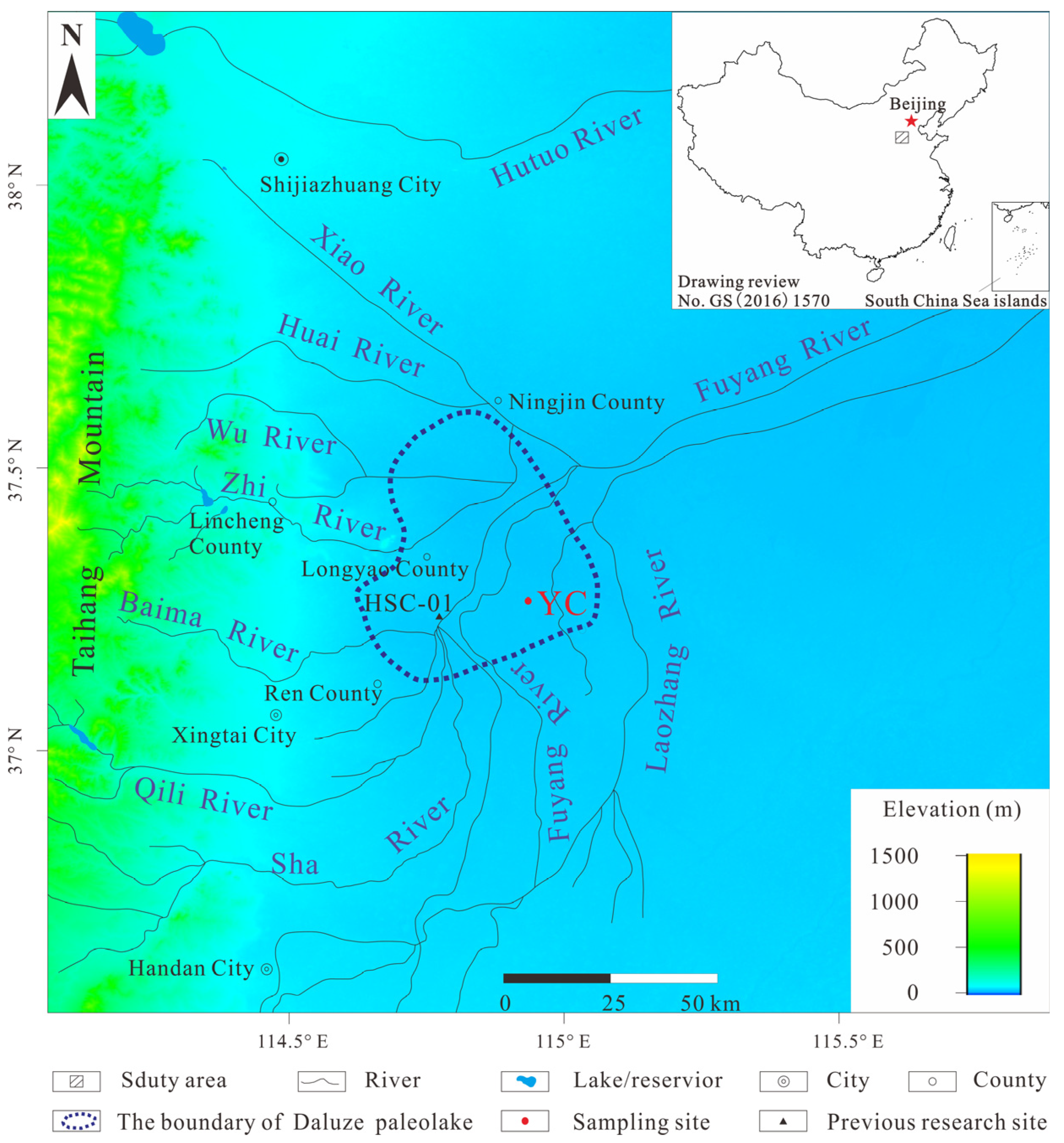
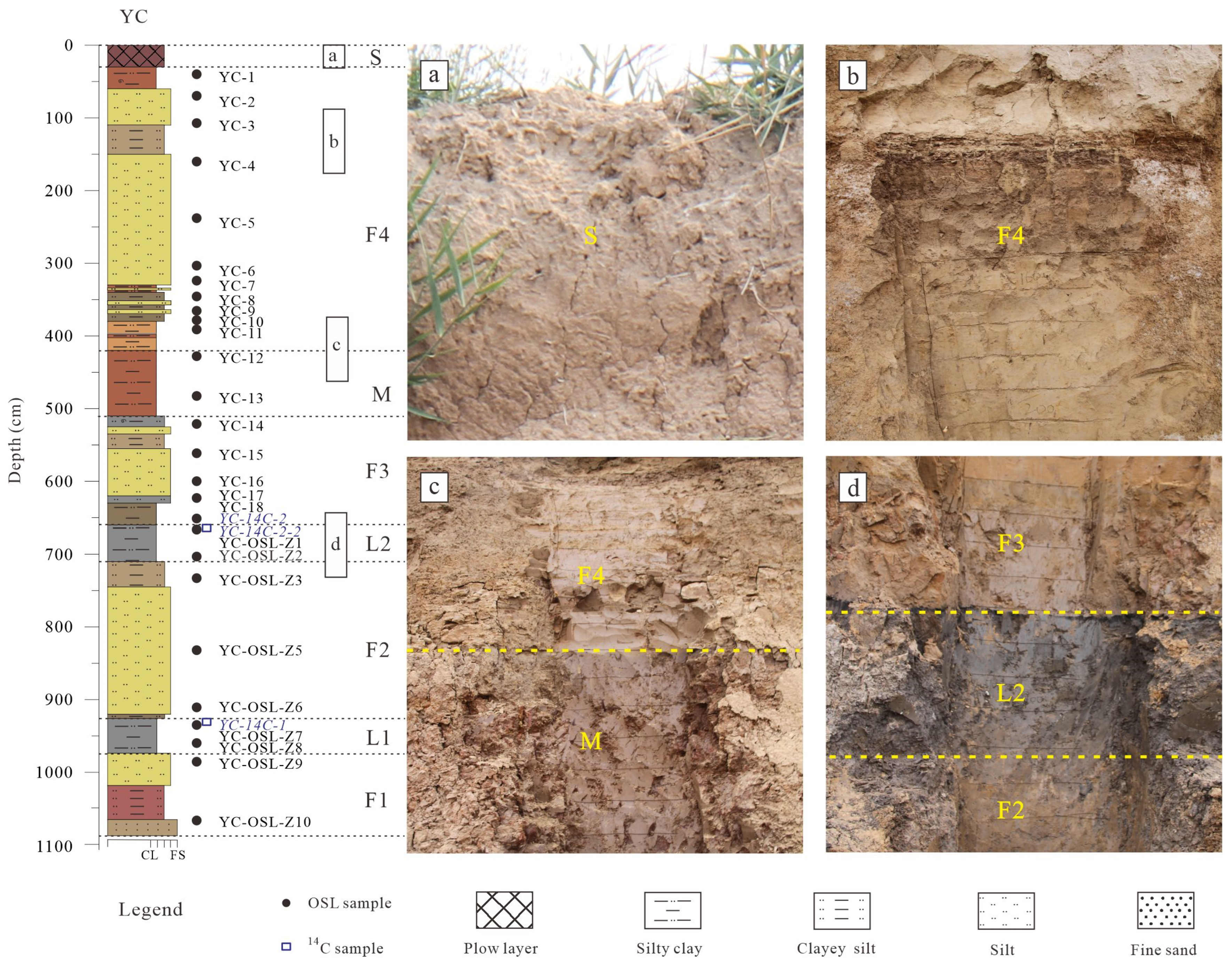
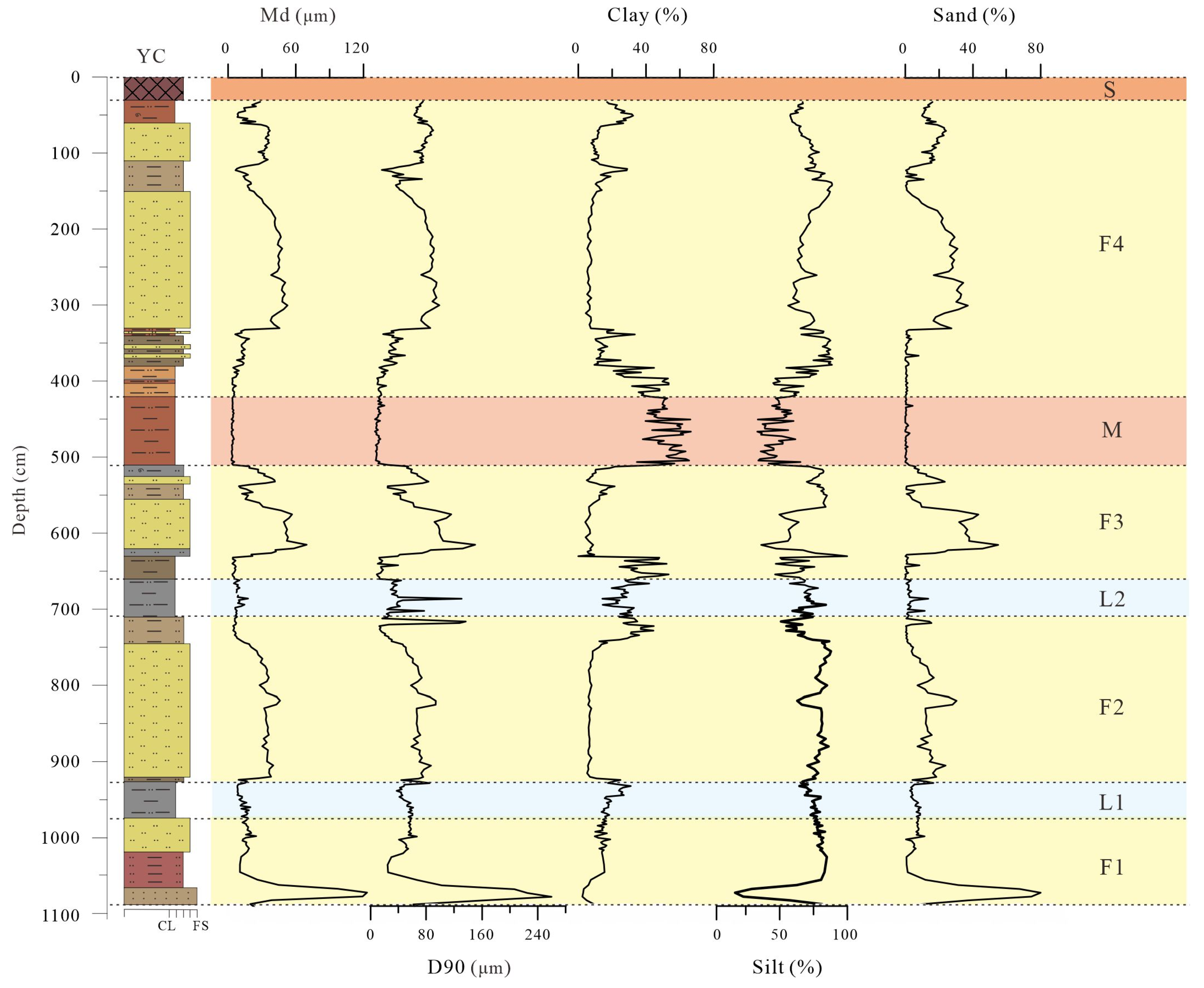
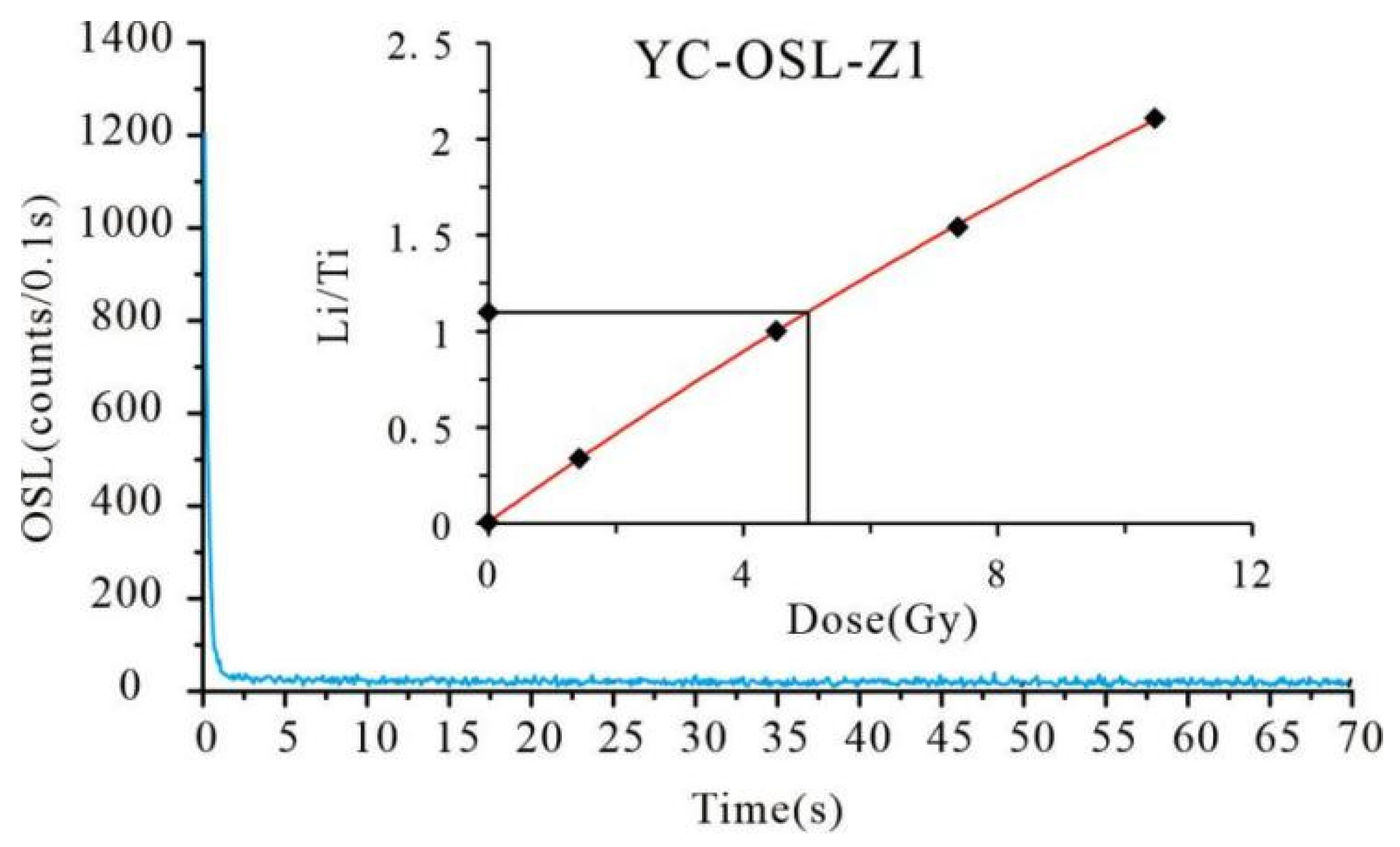
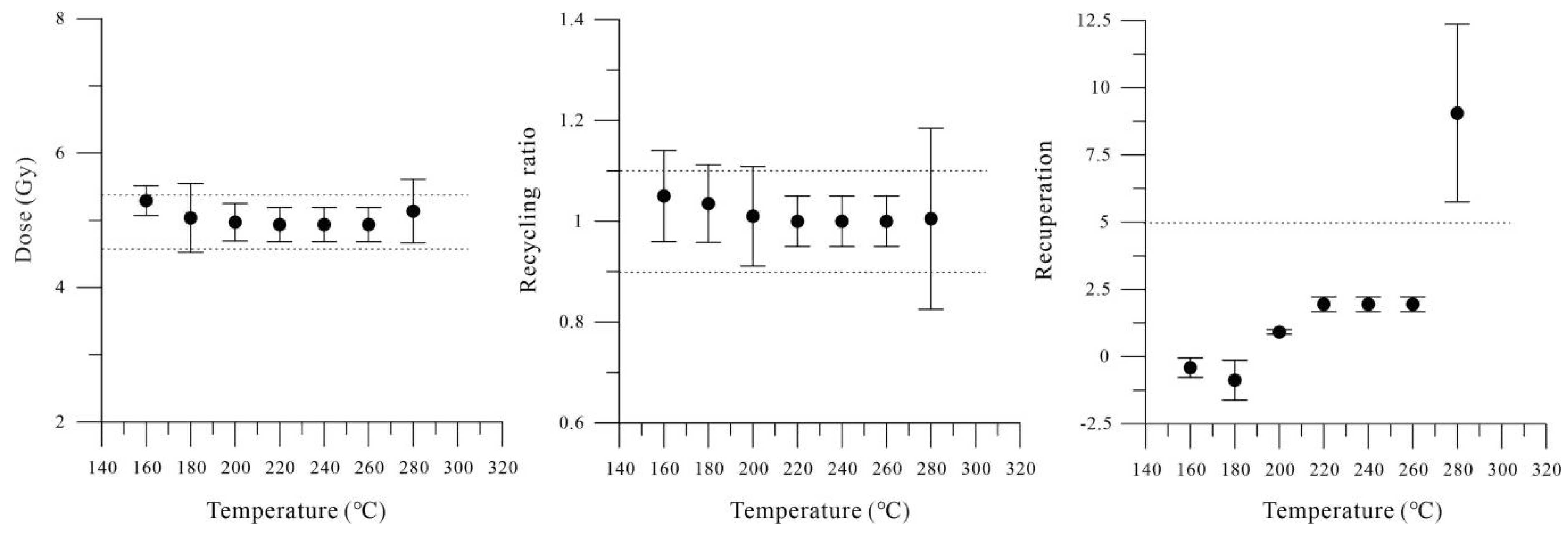
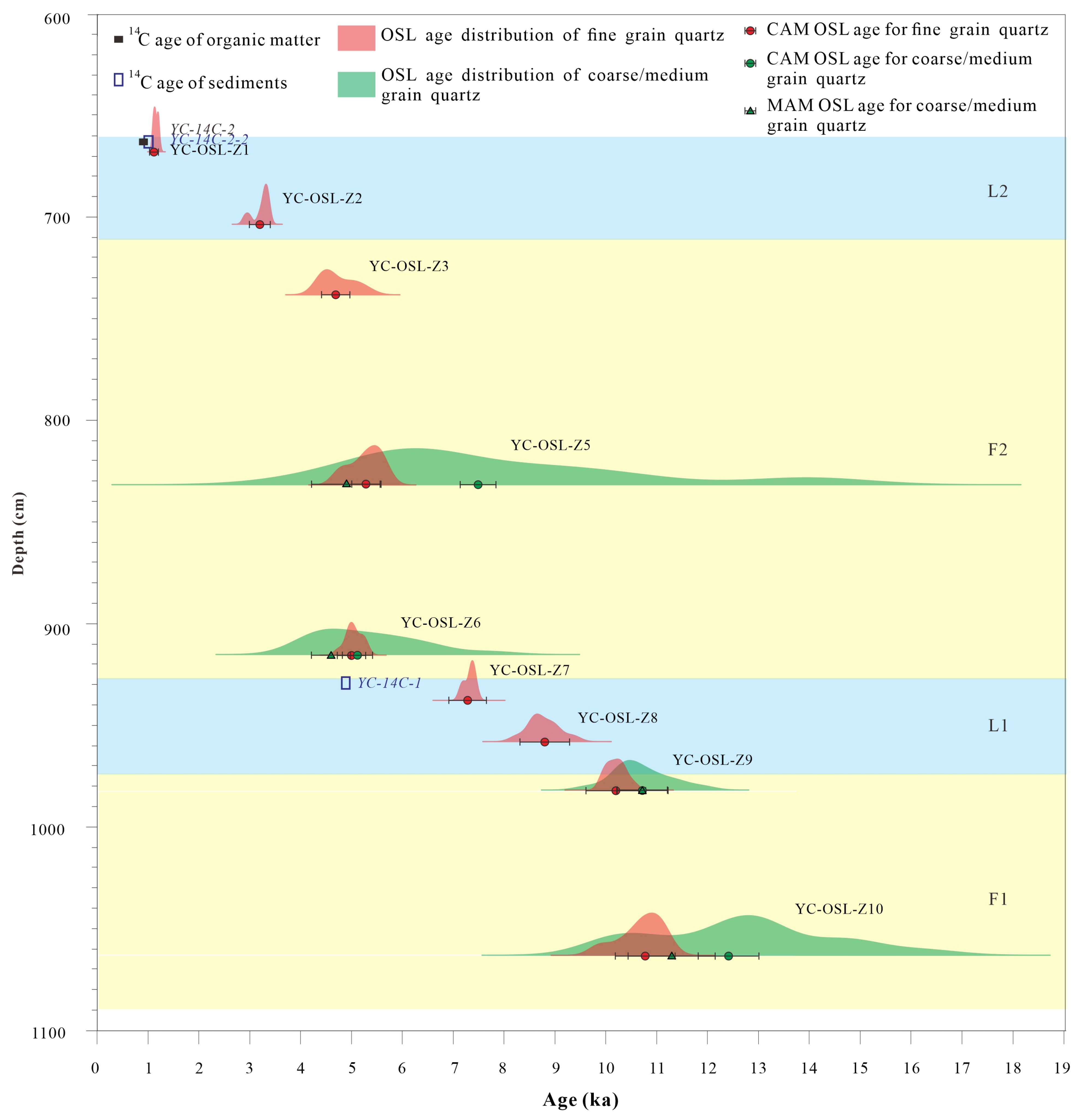
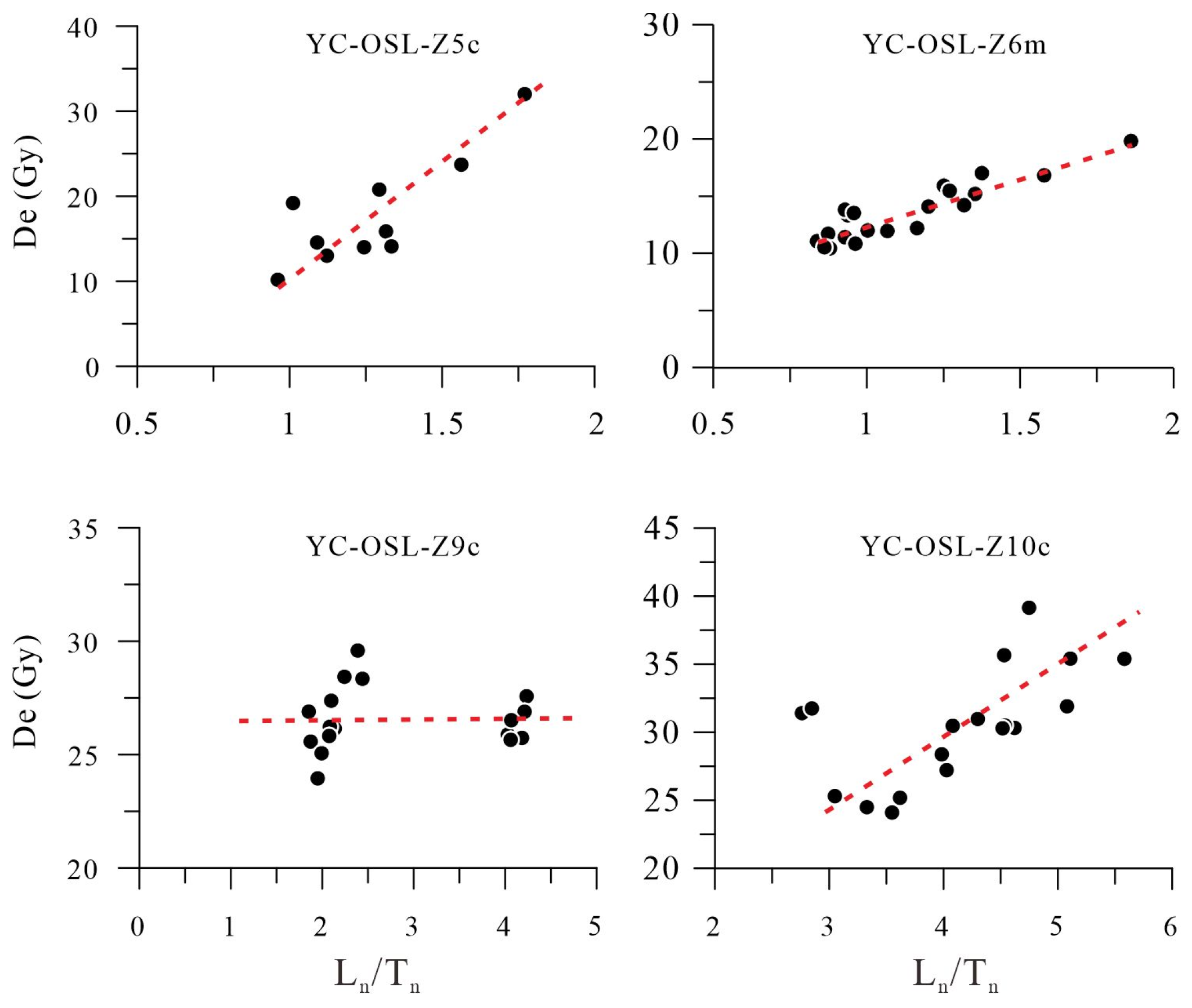
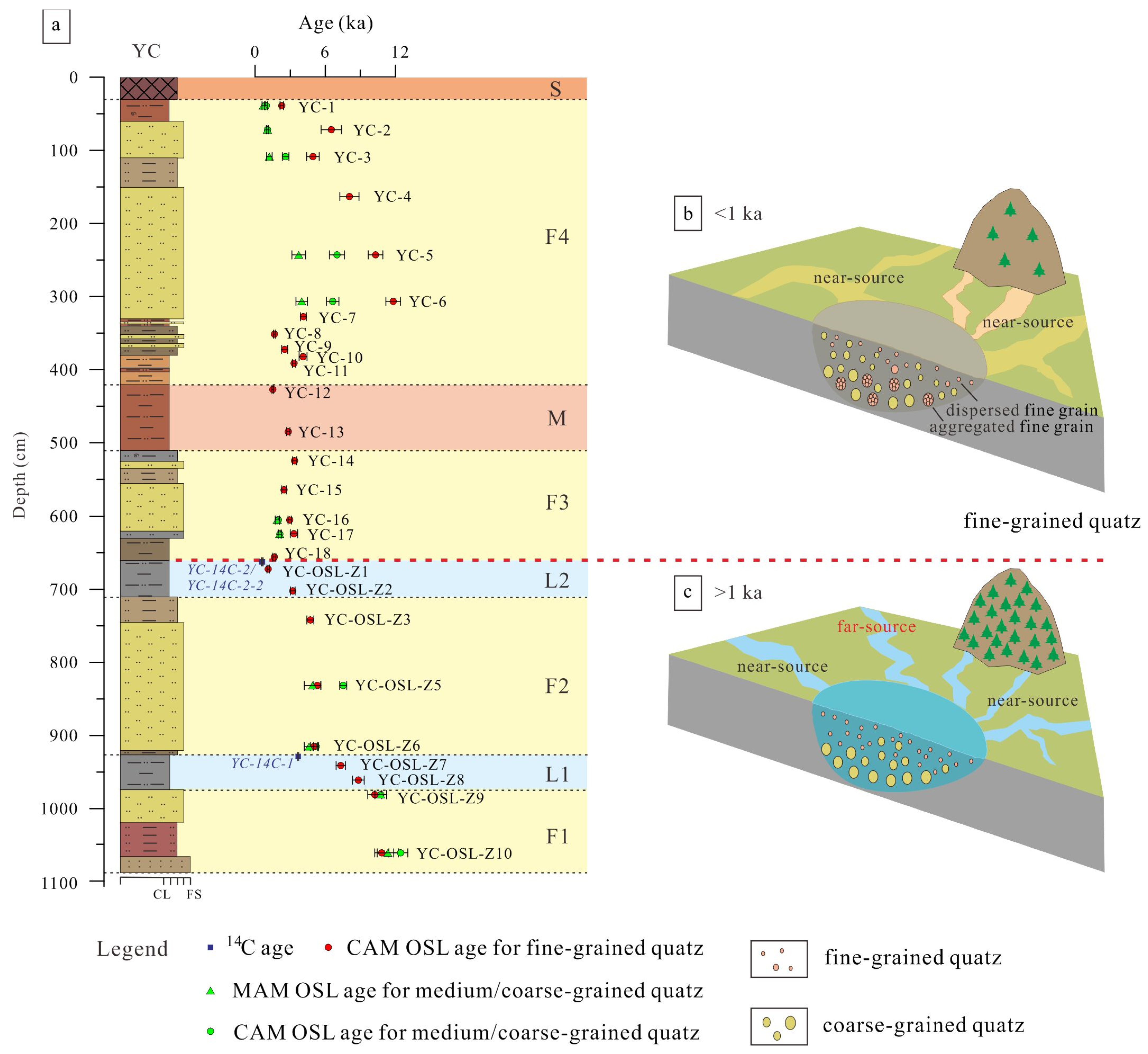
| Sedimentary Unit | Layer No. | Depth (cm) | Lithological Description |
|---|---|---|---|
| Modern soil layer (S) | 23 | 0~30 | Light brown soil, with plant roots and root holes |
| Fluvial Flood Layer 4 (F4) | 22 | 30~60 | Reddish-brown silty clay with shell fragments |
| 21 | 60~115 | Gray–yellow silt; 95~100 cm is brown–yellow clayey silt | |
| 20 | 115~150 | Light brown–yellow clayey silt; reddish-brown at 115~125 cm | |
| 19 | 150~330 | Gray–yellow silt | |
| 18 | 330~340 | Interbedded reddish-brown silty clay and gray–yellow clayey silt | |
| 17 | 340~380 | Interbedded brown clayey silt and brown–yellow silt | |
| 16 | 380~420 | Brown silty clay with greasy luster; bluish-gray at ~395 cm | |
| Mountain flood Layer (M) | 15 | 420~510 | Dark brown silty clay, blocky and structureless |
| Fluvial Flood Layer 3 (F3) | 14 | 510~525 | Bluish-gray clayey silt with shell fragments |
| 13 | 525~535 | Gray–yellow silt | |
| 12 | 535~555 | Brown–yellow clayey silt | |
| 11 | 555~620 | Gray–yellow silt | |
| 10 | 620~630 | Bluish-gray silt | |
| 9 | 630~660 | Brown silty clay | |
| Lacustrine Layer 2 (L2) | 8 | 660~710 | Gray–black silty clay with shell fragments; carbonaceous debris at 660 cm |
| Fluvial Flood Layer 2 (F2) | 7 | 710~745 | Brown–yellow clayey silt |
| 6 | 745~920 | Gray–yellow silt | |
| 5 | 920~926 | Brownish clayey silt | |
| Lacustrine Layer 1 (L1) | 4 | 926~970 | Gray–black silty clay |
| Fluvial Flood Layer 1 (F1) | 3 | 970~1020 | Gray–yellow silt; coarsens downward, transitional contact |
| 2 | 1020~1060 | Brown clayey silt with calcareous nodules | |
| 1 | 1060~1085 | Brown–yellow fine sand, well sorted; large shells at base |
| Step | Procedure |
|---|---|
| 1 | Give regenerative dose Di, for the natural sample Di = 0 |
| 2 | Preheat for 10 s at 220 °C (determined by preheat plateau test) |
| 3 | Stimulate for 70 s at 125 °C to measure signal Li (Ln for natural sample) |
| 4 | Give test dose (DT) |
| 5 | Cutheat to 160 °C, 0 s hold |
| 6 | Stimulate for 70 s at 125 °C to measure signal Ti (Tn for natural sample) |
| 7 | Return to 1 |
| Sediment Type | Value Type | Median Grain Size (μm) | D90 | Content (%) | ||
|---|---|---|---|---|---|---|
| Clay | Silt | Sand | ||||
| Fluvial Flood Layer | Maximum | 123.08 | 259.61 | 53.39 | 99.88 | 80.01 |
| Minimum | 3.71 | 9.22 | 0.00 | 17.06 | 0.00 | |
| Average | 24.66 | 58.36 | 16.40 | 71.73 | 11.87 | |
| Mountain Flood Layer | Maximum | 5.48 | 25.06 | 66.47 | 65.42 | 4.38 |
| Minimum | 2.98 | 6.59 | 34.58 | 33.53 | 0.00 | |
| Average | 3.88 | 11.08 | 52.35 | 47.04 | 0.61 | |
| Lacustrine Layer | Maximum | 41.56 | 130.80 | 41.85 | 84.15 | 23.39 |
| Minimum | 5.08 | 23.28 | 5.02 | 57.55 | 0.60 | |
| Average | 14.60 | 49.84 | 20.90 | 72.84 | 6.26 | |
| Sample No. | Given Dose (Gy) | Measured De (Gy) |
|---|---|---|
| YC-OSL-Z1 | 3 | 3.03 ± 0.24 |
| YC-OSL-Z1 | 6 | 6.04 ± 0.36 |
| YC-OSL-Z10 | 20 | 19.94 ± 0.81 |
| YC-OSL-Z10 | 40 | 41.61 ± 1.69 |
| Sample No. | Depth (m) | U (ppm) | Th (ppm) | K (%) | De (Gy) | Dose Rate (Gy/ka) | Water Content (%) | Age(ka) | OD | Grain Size (μm) | ||
|---|---|---|---|---|---|---|---|---|---|---|---|---|
| Common Age Model | Minimum Age Model | Common Age Model | Minimum Age Model | (%) | ||||||||
| YC-OSL-Z1 | 6.7 | 4.56 | 16.8 | 2.26 | 5.03 ± 0.04 | 4.45 ± 0.28 | 23 ± 5 | 1.1 ± 0.1 | 0.69 | 4~11 | ||
| YC-OSL-Z2 | 7.0 | 2.26 | 15.4 | 2.40 | 12.23 ± 0.19 | 3.84 ± 0.22 | 23 ± 5 | 3.2 ± 0.2 | 2.04 | 4~11 | ||
| YC-OSL-Z3 | 7.4 | 2.09 | 12.09 | 2.02 | 15.32 ± 0.25 | 3.26 ± 0.18 | 22 ± 5 | 4.7 ± 0.3 | 3.27 | 4~11 | ||
| YC-OSL-Z5f | 8.3 | 1.82 | 8.50 | 1.73 | 13.94 ± 0.17 | 2.66 ± 0.15 | 22 ± 5 | 5.3 ± 0.3 | 3.76 | 4~11 | ||
| YC-OSL-Z5c | 8.3 | 1.82 | 8.50 | 1.73 | 17.17 ± 0.27 | 12.84 ± 1.74 (σ = 14) | 2.29 ± 0.10 | 22 ± 5 | 7.5 ± 0.3 | 5.6 ± 0.8 (σ = 14) | 31.31 | 65~90 |
| 11.19 ± 1.49 (σ = 10) | 4.9 ± 0.7 (σ = 10) | |||||||||||
| 10.43 ± 1.00 (σ = 5) | 4.6 ± 0.5 (σ = 5) | |||||||||||
| YC-OSL-Z6f | 9.14 | 2.32 | 10.70 | 1.57 | 14.28 ± 0.16 | 2.84 ± 0.17 | 22 ± 5 | 5.0 ± 0.3 | 0 | 4~11 | ||
| YC-OSL-Z6m | 9.14 | 2.32 | 10.70 | 1.57 | 13.36 ± 0.14 | 12.45 ± 0.99 (σ = 14) | 2.55 ± 0.11 | 22 ± 5 | 5.2 ± 0.2 | 4.9 ± 0.4 (σ = 14) | 16.65 | 41~65 |
| 11.68 ± 0.82 (σ = 10) | 4.6 ± 0.4 (σ = 10) | |||||||||||
| 11.06 ± 0.57 (σ = 5) | 4.3 ± 0.3 (σ = 5) | |||||||||||
| YC-OSL-Z7 | 9.4 | 2.21 | 13.8 | 1.70 | 21.22 ± 0.21 | 2.92 ± 0.18 | 30 ± 5 | 7.3 ± 0.4 | 0 | 4~11 | ||
| YC-OSL-Z8 | 9.6 | 2.30 | 12.0 | 1.86 | 27.63 ± 0.34 | 3.16 ± 0.19 | 22 ± 5 | 8.8 ± 0.5 | 0 | 4~11 | ||
| YC-OSL-Z9f | 9.8 | 1.82 | 11.91 | 1.77 | 30.20 ± 0.31 | 2.96 ± 0.17 | 22 ± 5 | 10.2 ± 0.6 | 0 | 4~11 | ||
| YC-OSL-Z9c | 9.8 | 1.82 | 11.91 | 1.77 | 26.58 ± 0.21 | 26.54 ± 1.23 (σ = 14) | 2.49 ± 0.10 | 22 ± 5 | 10.7 ± 0.5 | 10.7 ± 0.7 (σ = 14) | 3.80 | 90~125 |
| 26.54 ± 0.68 (σ = 10) | 10.7 ± 0.5 (σ = 10) | 90~125 | ||||||||||
| 26.54 ± 0.66 (σ = 5) | 10.7 ± 0.5 (σ = 5) | 90~125 | ||||||||||
| YC-OSL-Z10f | 10.6 | 1.92 | 10.2 | 1.72 | 30.67 ± 0.31 | 2.85 ± 0.17 | 20 ± 5 | 10.8 ± 0.6 | 0 | 4~11 | ||
| YC-OSL-Z10c | 10.6 | 1.92 | 10.2 | 1.72 | 29.77 ± 0.30 | 29.77 ± 0.83 (σ = 14) | 2.41 ± 0.10 | 20 ± 5 | 12.4 ± 0.6 | 12.4 ± 0.9 (σ = 14) | 12.69 | 90~125 |
| 27.17 ± 1.80 (σ = 10) | 11.3 ± 0.9 (σ = 10) | |||||||||||
| 25.33 ± 1.23 (σ = 5) | 10.5 ± 0.7 (σ = 5) | |||||||||||
| Lab No. | Sample ID | Depth (cm) | Material | 14C Age (BP) | 2σ Calibrated Age (cal BP) | Mean Cal Age (cal BP) |
|---|---|---|---|---|---|---|
| LZU14171 | YC-14C-1 | 926~929 | Silty clay | 4350 ± 20 | 4855~4966 | 4910.5 |
| LZU14170 | YC-14C-2 | 660 | Organic matter | 1070 ± 20 | 927~997 | 962 |
| LZU14170-1 | YC-14C-2-2 | 660 | Silty clay | 1145 ± 25 | 963~1080 | 1021.5 |
Disclaimer/Publisher’s Note: The statements, opinions and data contained in all publications are solely those of the individual author(s) and contributor(s) and not of MDPI and/or the editor(s). MDPI and/or the editor(s) disclaim responsibility for any injury to people or property resulting from any ideas, methods, instructions or products referred to in the content. |
© 2025 by the authors. Licensee MDPI, Basel, Switzerland. This article is an open access article distributed under the terms and conditions of the Creative Commons Attribution (CC BY) license (https://creativecommons.org/licenses/by/4.0/).
Share and Cite
Liu, Z.; Yang, J.; Zhao, H.; Song, L.; Wang, C. Luminescence Dating of Holocene Fluvial Sediments from the Daluze Area in the North China Plain. Water 2025, 17, 1942. https://doi.org/10.3390/w17131942
Liu Z, Yang J, Zhao H, Song L, Wang C. Luminescence Dating of Holocene Fluvial Sediments from the Daluze Area in the North China Plain. Water. 2025; 17(13):1942. https://doi.org/10.3390/w17131942
Chicago/Turabian StyleLiu, Zhe, Jinsong Yang, Hua Zhao, Lei Song, and Chengmin Wang. 2025. "Luminescence Dating of Holocene Fluvial Sediments from the Daluze Area in the North China Plain" Water 17, no. 13: 1942. https://doi.org/10.3390/w17131942
APA StyleLiu, Z., Yang, J., Zhao, H., Song, L., & Wang, C. (2025). Luminescence Dating of Holocene Fluvial Sediments from the Daluze Area in the North China Plain. Water, 17(13), 1942. https://doi.org/10.3390/w17131942






